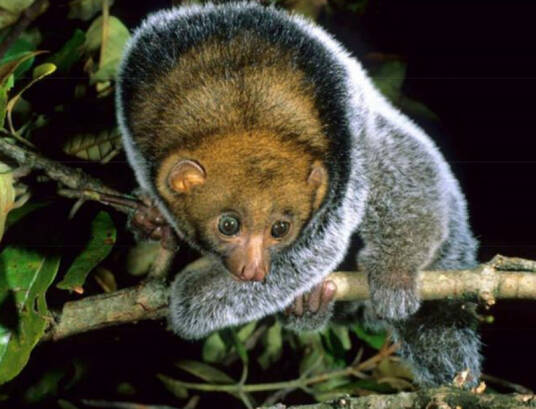Perodicticus ibeanus
IUCN
LCBasic Information
Scientific classification
- name:Perodicticus ibeanus
- Scientific Name:Perodicticus ibeanus,East African Potto, Eastern Potto
- Outline:Primates
- Family:Loris
Vital signs
- length:About 35 cm
- Weight:1-1.2kg
- lifetime:No verification information
Feature
The body emits a pungent smell similar to curry, which is used to mark the territory
Distribution and Habitat
Distributed in Burundi, Democratic Republic of Congo, Kenya, Rwanda and Uganda.
Habitat is 600-2300 m above sea level. Lives in tropical forests of Africa, inhabiting all layers of lowland and montane moist forests, swamp forests and other lowland forest types. Densities are lower in gardens and coniferous forests near secondary forests in western Kenya. The species is most common in forest edges, flooded primary forests, secondary forests and submerged forests. Average annual rainfall in its geographic range is 60-230 cm.
Appearance
The Koala is about 35 cm long and weighs 1-1.2 kg. Its tail is 5 cm long on average, which is only half the length of the slow loris. It has large eyes and strong night vision. Its fur is thick, curly, gray-brown, and black hair on the back. Its hands and feet are dark brown. They are secretive and slow in movement. They have hands that are good for grasping, with thumbs and other fingers opposite, and can hold branches of various shapes. Koalas cannot run away, and there are protruding spines on the vertebrae from the neck to the shoulder blade for defense. When attacked, it arches its body so that the enemy can only bite its shoulders, and its long and pointed bones protrude to protect itself from harm. The body emits a pungent smell similar to curry, which is used to mark territory. Compared with other species of the same genus, Koalas have smaller teeth.
Details
East African Potto (scientific name: Perodicticus ibeanus) is called East African Potto and Eastern Potto in foreign languages. There are two subspecies.

East African Potto is a nocturnal animal, coming out at night and hiding during the day. It lives in trees. They walk slowly and carefully in trees, like a tightrope walker, foraging in all forest layers but preferring the canopy. They are omnivorous, eating mostly ripe fruits, gums, nectar and invertebrates, but also mosses, frogs and bird eggs.
The East African koala monkey is widely distributed in secondary and primary forests and plantations near human habitation. The main threat is habitat loss. These causes are probably not a major threat to population decline within the large distribution range. However, habitat loss due to logging and intensive agriculture has been associated with rapid local human population growth, and rapid local declines in the species are occurring in many geographic areas. In northern Congo, people trade small amounts of pottery for pets and body parts for various local medicines and witchcraft (Svensson et al. 2016). The species is easily spotted by torchlight and is therefore easily found by hunters.
Listed in the IUCN Red List of Threatened Species in 2017 ver3.1 - Least Concern (LC).
Listed in the CITES Appendix II of the Washington Convention as a protected animal.
Protect wild animals and eliminate game.
Maintaining ecological balance is everyone's responsibility!








